Impressive Dunster Castle – Step Back in Time in Somerset
Dunster Castle, located in the small village of Dunster in Somerset, England, is one of the finest remaining examples of a fortified stronghold from the Tudor period. Offering over 1,000 years of history, Dunster Castle is filled with stories that come to life when you tour the castle rooms.
Dating back to the 11th century, the ancient castle is built on a hill with a dramatic view of the surrounding countryside. It has seen countless historical events, from Norman invasions to the English Civil War. In its glory days, Dunster Castle hosted polo matches and society balls.
Today, Dunster Castle attracts tourists from all over the world. The National Trust operates this Grade I listed building. Docents will help you understand critical historical facts about the castle, including background on the Luttrell family, who once occupied the magnificent building.
At Dunster Castle, you’ll discover the castle itself and the serene gardens, acres of woodland, and hidden paths that all lead to an unforgettable experience.
The Places Where We Go contains affiliate links and is a member of the Amazon Services LLC Associates Program. As an Amazon Associate, we earn from qualifying purchases at no extra cost to you when you purchase using one of these Amazon links. Read our disclaimer and privacy policy for more information.
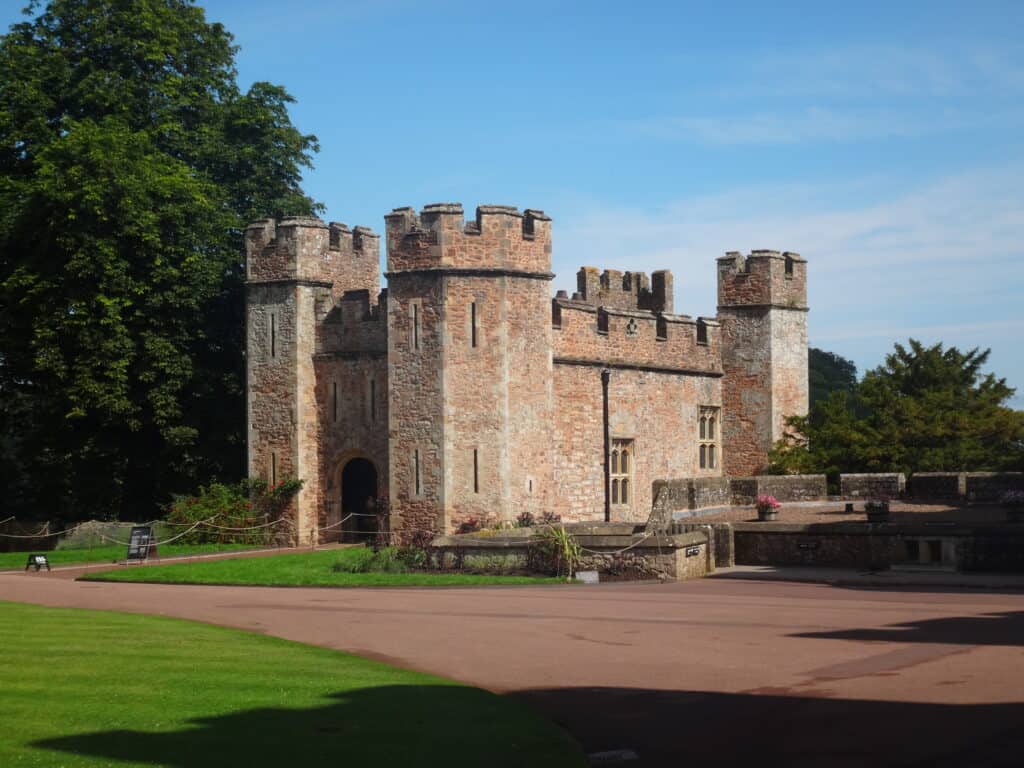
Overview of Dunster Castle
Dunster Castle offers visitors an immersive experience of the rich history of England through its impressive architecture and fascinating stories. From its strategic hilltop location to its opulent rooms and beautiful gardens, Dunster Castle is a window to the history of Britain. In the following sections, we will delve into some of its notable features and unravel the secrets hidden within its walls.
The Castle Grounds: A Peaceful Oasis
The castle grounds span nearly 1,000 acres and provide views of the Bristol Channel and Exmoor. This area has various wildlife, from pheasants and red deer to buzzards and butterflies.
We arrived one hour before the castle officially opened for a stroll in the castle gardens. The relaxing walk takes visitors down tranquil winding paths that feature various plants, flowers, and ancient trees. Several of these appeared to be imported from multiple places across the globe. An early arrival lets visitors avoid crowds that often arrive later in the day.
The River Avil runs through the garden at Dunster Castle. Bridges that span the River Avill lead to walking paths over the property.
A visit during late spring or early summer will let you experience an English garden in full bloom. And remember your camera, as the outside provides excellent specimens for photography.
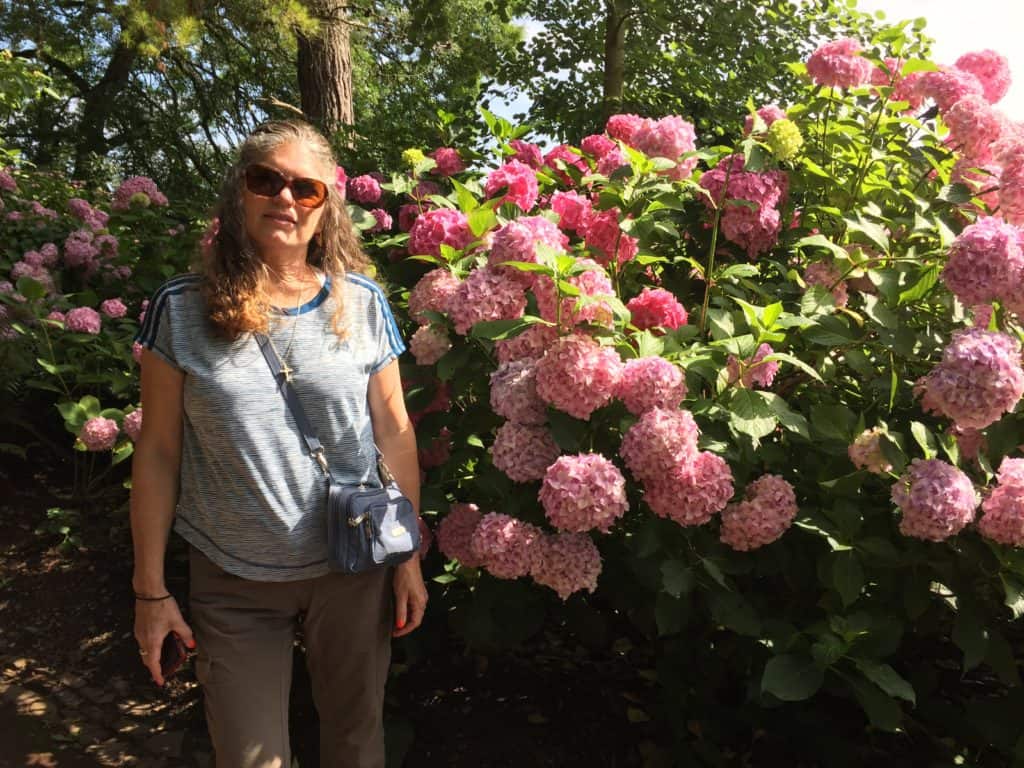
Dunster Watermill
On these grounds an old but restored working watermill from the 18th century. We toured this facility where they still mill a good amount of grain daily sold on castle premises. Visitors can view several levels of the structure. The steps to the top are somewhat steep via the mill step ladder, so you need to be comfortable traversing the steps.
Workers at the mill provide interesting information about the workings of this mill. It’s a fascinating feature on the castle grounds. We were told the mill produces between six to eight tons of flour annually. You can purchase yours on the grounds of Dunster Castle in the gift shop.
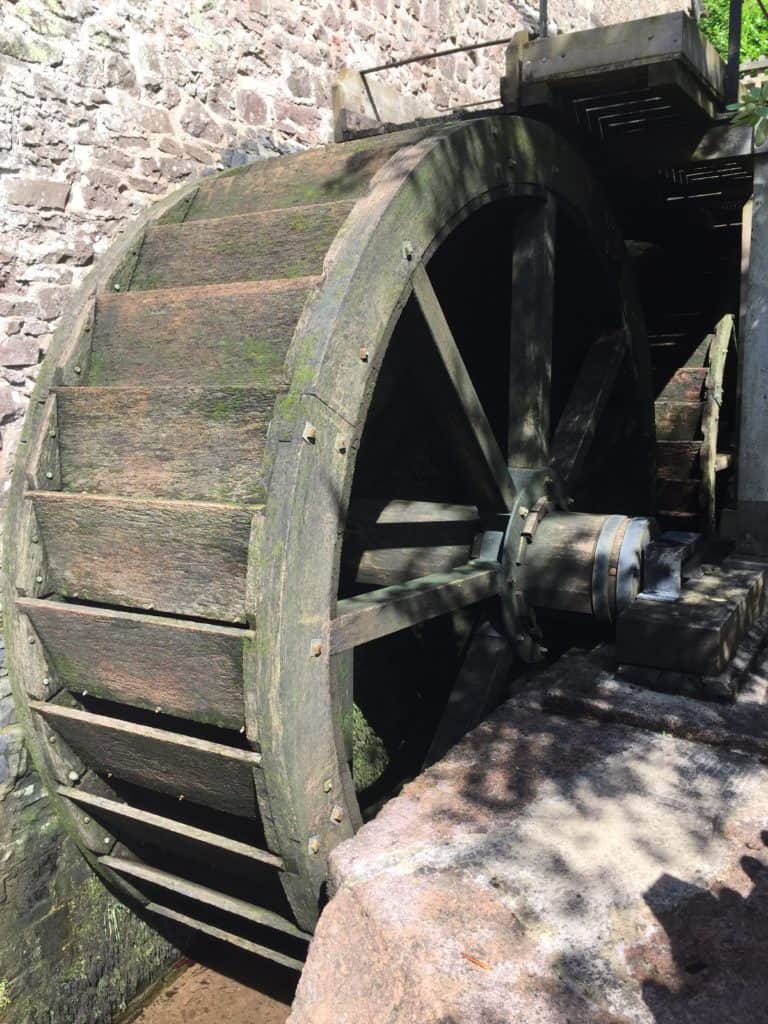
Interior of Dunster Castle
Visitors can tour Dunster Castle in a self-guided mode. Upon entering the castle, you can pick up a booklet that guides your walk through the castle.
Impressive areas of the castle include the home’s library, dining room, and living quarters. The craftsmanship throughout the castle is superb – with intricate wood carvings on the wood staircase as one example. It’s very fancy.
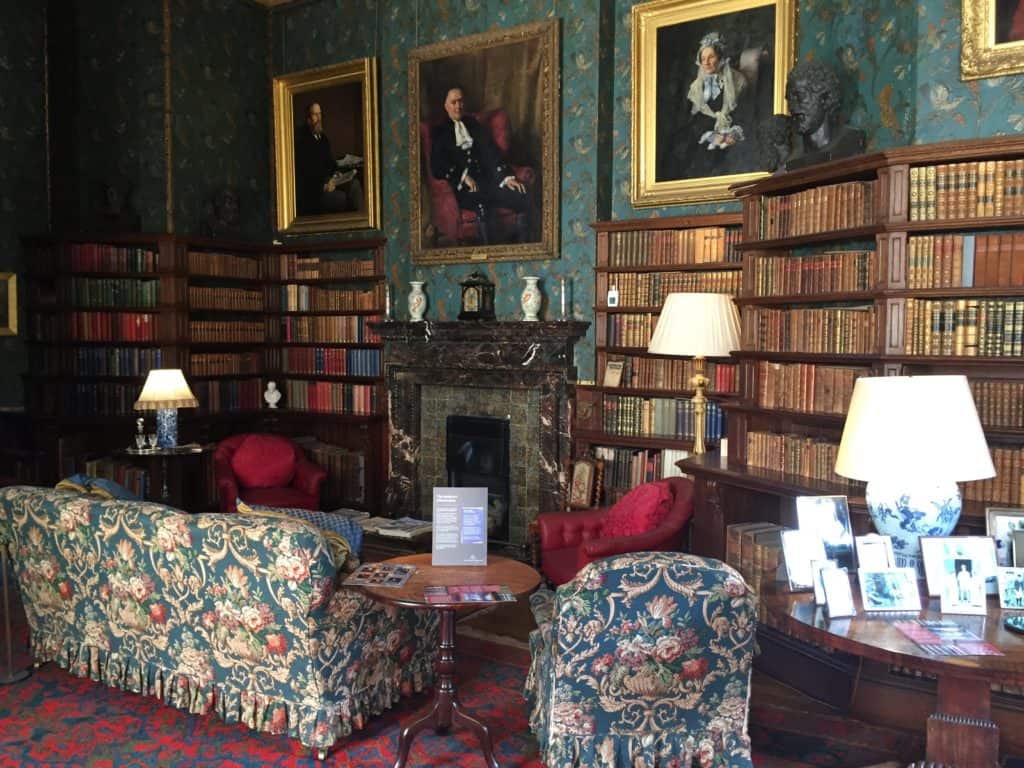
Redecoration work inside the castle provides an authentic period feel to the property. You’ll see old-style wallpapers hung on walls and old-school materials used throughout the castle property.
Fun Fact: Dunster Castle had the first plumbed-in bath in Somerset.
The billiard room had the largest pool table we’ve ever seen. On the wall was a list of no less than 60 billiard rules. Examples: when the player asks for silence in the room, all will obey; nobody can offer the player advice, etc. We suspect many a heated argument back in the day in this pool room.
Several tour add-ons were available (e.g., Kitchen Tour). Without the tour additions, our self-guided walk took two hours.
Dunster Castle Piano
There is a Bluthner baby grand piano in one of the main rooms with a sign telling guests they can play if they know how. The piano once belonged to composer Vivian Ellis. I took the piano for a play with a light version of a Chopin Mazurka.
Unusual Features of Dunster Castle
Dunster Castle, built for military purposes, has some unusual features that make it stand out from other castles in Somerset and many British castles. Its towers and roofs are adorned with over 130 carved stone heads added in the 19th century.
The castle also houses an impressive collection of furniture and artwork from the 17th-century parties hosted by the Luttrell family. It’s fun to explore the castle’s hidden spaces and discover the winding staircases, narrow corridors, and fine furnishings that make it a unique place.
Delightful Views From the Castle
One of the castle’s main attractions is undoubtedly its stunning views. You can tour the castle keep, climb the battlements, and take in the incredible views of the village of Dunster and the surrounding countryside. The sweeping views are the perfect reward for the climb, and as you stand there, you can appreciate the castle’s position as a stronghold designed to keep enemies at bay.
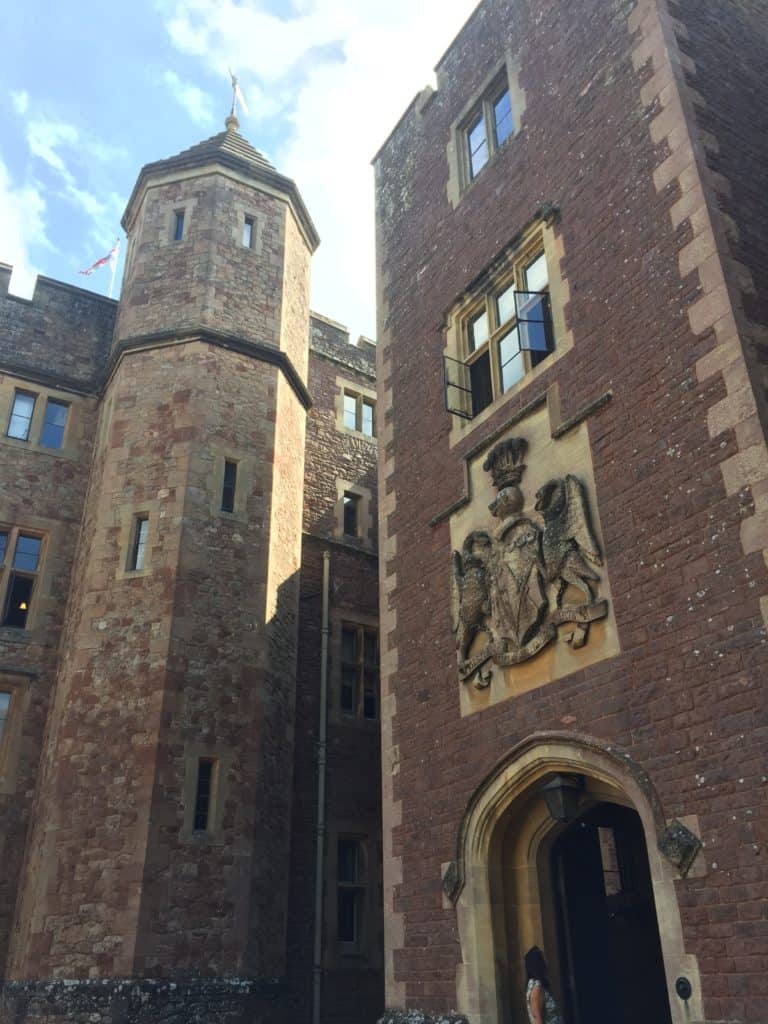
Architecture of Dunster Castle
The architecture of Dunster Castle is a fascinating combination of Norman, Tudor, and Georgian styles. Built on top of Tor Hill, the former motte and bailey medieval castle consists of two baileys or fortifications, with the oldest part being the inner bailey from the 11th century. Here you’ll find a four-story tower in Norman style that was completed in 1107 and served as a keep for centuries.
The outer bailey, built in the 15th century, is surrounded by a massive moat and contains two gatehouses, including the 13th century gatehouse. The castle had undergone several renovations, most notably during the 18th century when Sir John Luttrell remodeled it to mirror Georgian styling. The Luttrell family built a large manor house within the castle’s Lower Ward in 1617.
Even though you will see some Norman features on the outside of the building today, the interiors have been completely redesigned in Georgian fashion. Visitors can view an impressive 17th century carved staircase, ornate plaster ceilings, and rare leather wall hangings.
One of the key architects involved in the renovations of Dunster Castle was architect Anthony Salvin. Salvin was a prominent British architect who specialized in restoration and reconstruction projects for historic buildings. Employed by George Luttrell, Anthony Salvin worked on several parts of the castle, including the gatehouse entrance and the chapel. His work can also be seen in other areas, such as the library, dining room, and kitchen, where he incorporated medieval and Tudor styles to create a cohesive look throughout the castle. Thanks to his efforts, Dunster Castle stands today as an exceptional example of architectural fusion from different time periods.
Fascinating Dunster Castle History
Dunster Castle has lived through some of England’s most significant historical moments.
A timber castle was first constructed on the site of Dunster Castle in 1066 when de Mohun Williams became England’s new king. The timber structure weakened over just a couple of centuries, and the original castle needed a complete reconstruction.
In 1379 Dunster Castle passed to the Luttrell family. In the late 1500s, the property began to be transformed into a luxurious mansion.
For 600 years, 21 generations of Luttrells lived at this castle. Dunster Castle was largely altered in the 17th century. Today, little remains of the medieval castle except for the 13th-century gatehouse.
During the Civil War in 1646, Dunster Castle was one of the last places in Southwest England to surrender to parliamentary forces.
During the 17th century, the castle was transformed into a country house. It remained a family home until 1976, when the National Trust obtained Dunster Castle from Walter Luttrell. The National Trust restored Dunster Castle to its former glory.
Today, the castle is protected for future generations to enjoy its fascinating history and remarkable features.
Visiting Dunster Castle
The best time to visit Dunster Castle is during the spring and summer months when the flowers are blooming, and the gardens are at their most vibrant. A recommended amount of time to spend on a visit would be around 2-3 hours, giving you enough time to explore the castle’s interiors and beautiful grounds. Tickets can be purchased online or at the castle’s entrance, and there are also options for guided tours.
Dunster Castle and Gardens are open daily from 10 am to 5 pm.
Getting to Dunster Castle
Dunster Castle is located in the village of Dunster, about eight miles from Minehead on the beautiful Exmoor coast. The castle is easily accessible and can be reached by car or public transport.
By Car: Take the A39 road to Dunster (approximately 8 miles) from Minehead. When you reach Dunster, follow the signs to Dunster Castle.
By Public Transport: Take the West Somerset Railway to Dunster Station (approximately 15 minutes) from Minehead. The castle is a pleasant 20-minute walk away from the station. There are also regular bus services available from Minehead to Dunster Village. Once you arrive at the village of Dunster, follow the signs to Dunster Castle, and you will find the castle car park on your left. From there, it’s a short walk to the castle’s entrance.
Map of Dunster Castle Location via Google Maps
Public Transport Directions
Bus/Route No: 28 (Buses for Somerset) or Exmoor Coaster
Route Description: 28 Taunton – Minehead (Approx. every 2 hours, Mon-Sun)
Walking distance from to Bus Stop: Approximately 100 yards
Nearest Mainline station: Taunton.
Food at Dunster Castle
For a traditional English culinary experience, you can enjoy an excellent cream tea in a garden setting. A cute tea house provides an option for a light lunch, cream tea, and fruit scones served with clotted cream and jam. It’s a wonderful setting for afternoon tea alongside the river and beautiful flowers.
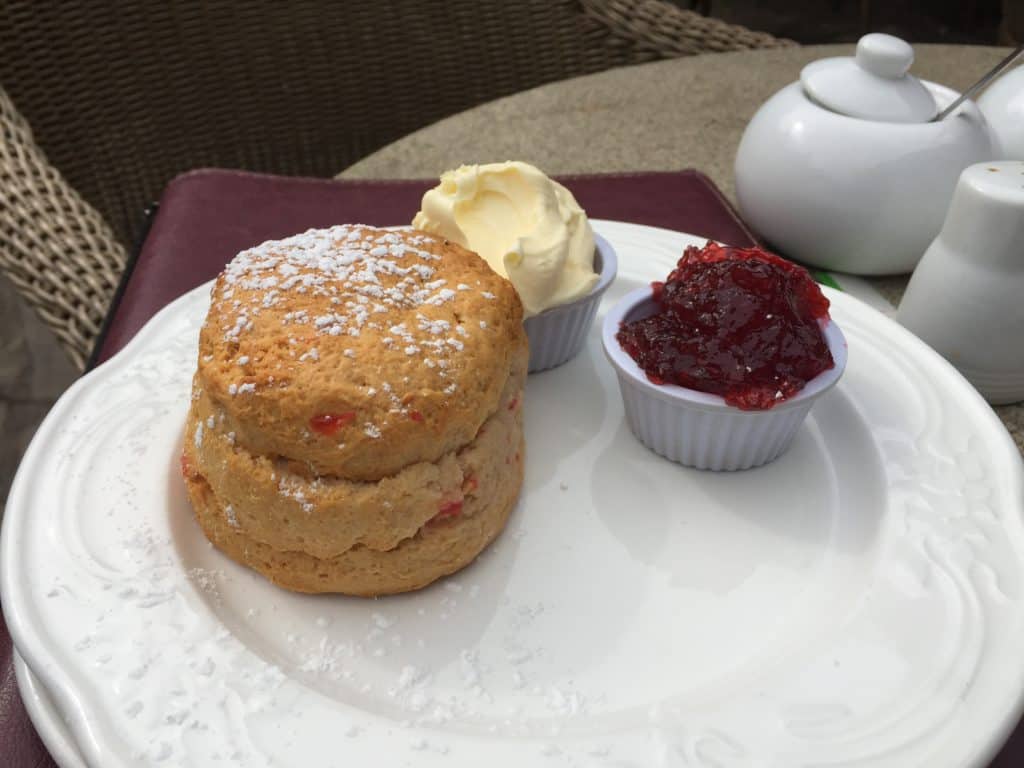
Dunster Castle Events
Consult the Dunster Castle Events page for a current listing of scheduled events at Dunster Castle.
Check Out Upcoming Events at Dunster Castle
Dunster Castle Location and Contact Information
Dunster Castle
Castle Hill
Dunster, Nr Minehead
TA24 6SL
United Kingdom
T: 01643 821314
E: dunstercastle@nationaltrust.org.uk
W: nationaltrust.org.uk/dunster-castle/
Facebook: @nationaltrust
Twitter: @DunsterCastleNT
Instagram: @dunstercastlent/
Where to Stay Near Dunster Castle
Exmoor House
We highly recommend staying at Exmoor House in Dunster. It’s where we spent several nights when we visited Dunster. This quaint Bed and Breakfast offers personality and an environment conducive to a relaxing stay. You’ll enjoy a wonderful breakfast in the morning, enjoy a clean room and comfortable bed during your stay.
Click for Rates and Availability at Exmoor House
More lodging options in Dunster:
Other Nearby Activities Near Dunster Castle
After exploring the castle, spend some time exploring the quaint Dunster Village. The medieval village offers intimate tea rooms, excellent dining rooms for lunch or dinner, and boutique shops.
You can even stroll to the top of the main street, which will take you to an entrance to Exmoor National Park. There is an excellent walking path where you can relax in the beautiful countryside.
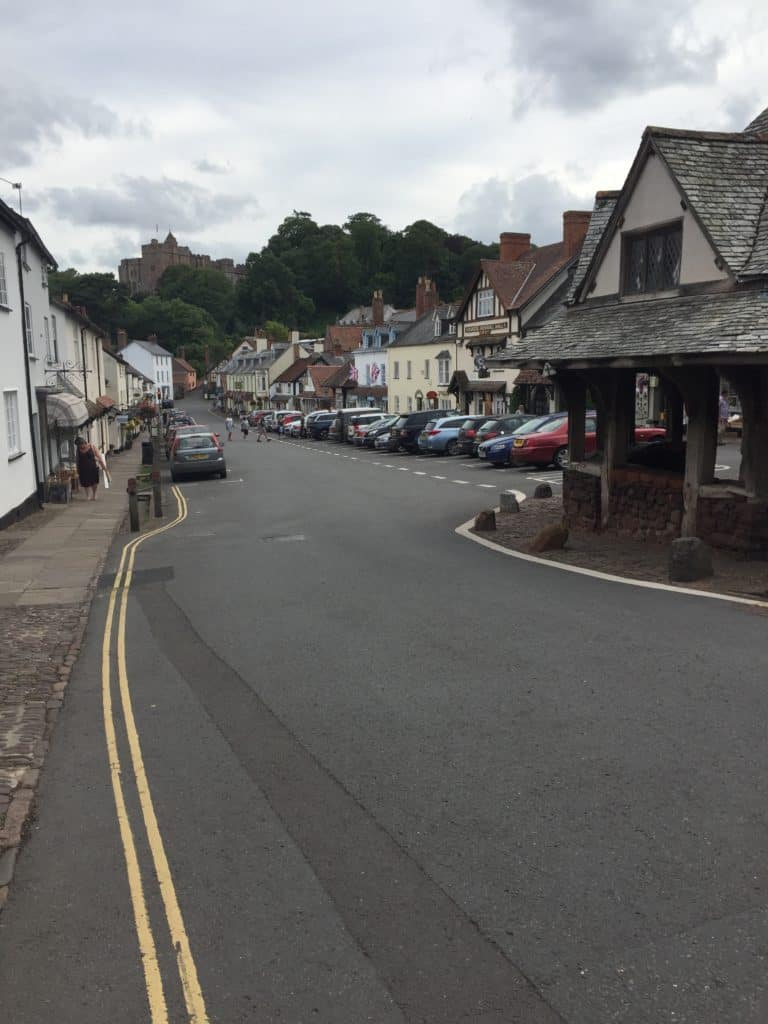
Frequently Asked Questions – FAQ
Yes, you can get married at Dunster Castle! With its beautiful grounds and impressive architecture, this stunning venue is the perfect place to tie the knot. The castle has a dedicated wedding coordinator who will work with you to ensure your special day runs smoothly and your needs are met. The castle and its grounds can provide the perfect backdrop for your special day.
Dunster Castle is famous for combining Norman, Tudor, and Georgian styles. The castle has undergone several renovations, most notably during the 18th century when Sir John Luttrell remodeled it to mirror Georgian styling. While you can see some Norman features on the outside, the interiors of Dunster Castle have been completely redesigned in a Georgian fashion. All these features combine to make this castle one of England’s most unique and beautiful monuments and ensure its lasting fame.
Events do take place at Dunster Castle. The summer season typically offers a variety of fun-filled activities, musical events, and theatre performances at the castle and gardens. Check the Dunster Castle website to see what’s on during your visit.
No, no one currently lives in Dunster Castle. It is now a tourist attraction managed by The National Trust. Julian Luttrell was the last of the Luttrell family, who owned the castle for 600 years.
Several film and television productions have been filmed at Dunster Castle. Among these are “The Famous Five” (an adventure family series based on Enid Blyton’s classic books), “The Apothecary” (2010), “Mud” (1994-1995) – a children’s television series, and “George Clarke’s National Trust Unlocked.”
Books About Dunster Castle
We like to learn about the places we visit by reading books. If you’re heading to Somerset, here are a few we recommend about Dunster.
|
Primary Rating:
3.5
|
Primary Rating:
4.2
|
Primary Rating:
5.0
|
|
$15.40
|
$12.75
|
$35.57
|
Dunster – Know Before You Go
Postal Code: TA24 6TH
⏰ Time Zone: British Summer Time (GMT+1) typically April – October
✈️ Closest Airport: Bristol Airport (BRS)Airport – located about 90 minutes away.
💰 Currency: Pound Sterling
🔌 Electricity Socket: You’ll find the Type G socket. This is a plug with three rectangular pins in a triangular pattern. The United Kingdom operates on a 230V supply voltage and 50Hz. For visitors from other countries, you’ll need this universal travel adaptor.
Exploring Dunster Podcast
Listen to our podcast that recapped this visit at the link below:
Closing Thoughts on Dunster Castle
Dunster Castle in Somerset allows tourists to glimpse medieval and Tudor England. The stunning views, tranquil gardens, and fascinating castle history offer the perfect place to spend a day exploring. A trip to the castle makes for an unforgettable experience.
Whether you are a history enthusiast, a nature lover, or simply looking for a family day out, Dunster Castle has plenty to offer. So, add this wonderful attraction to your itinerary when visiting beautiful Somerset, England.
Thanks for reading. We hope to see you at the places where we go.
Julie & Art
#dunstercastle
Read About More Things To Do Nearby Dunster
Explore Dunster – A Perfect Itinerary
Somerset: Visiting Somerset – A Charming English County
Watchet, England: Your Ultimate Must-See Guide
Ride the West Somerset Railway
A Perfect Weekend in Wells, England

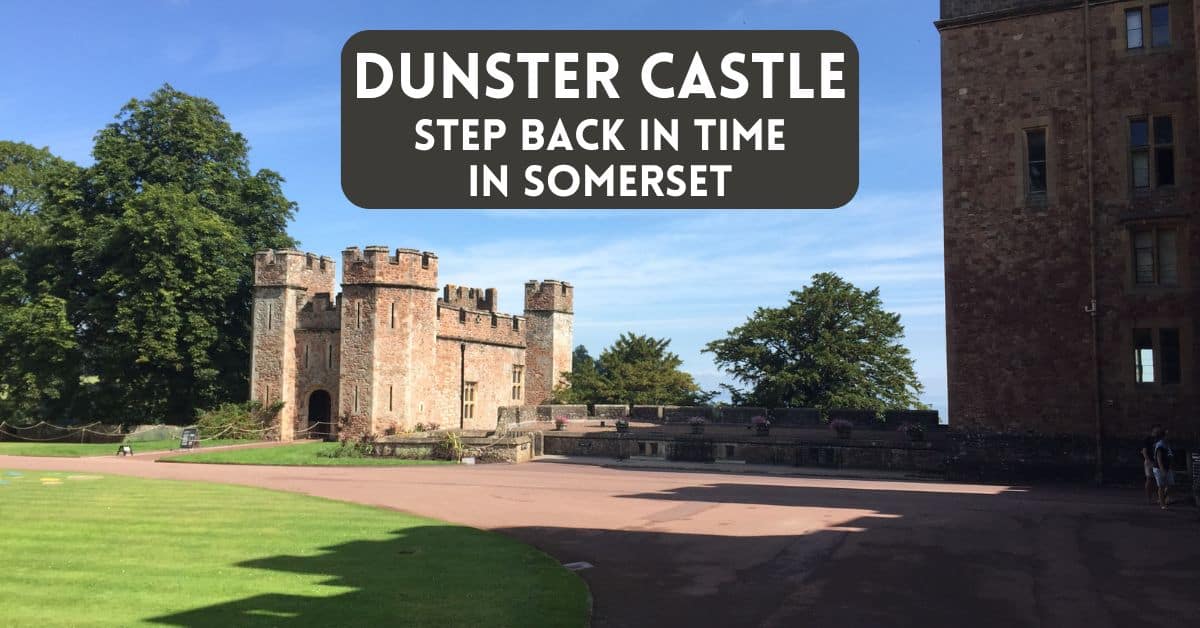
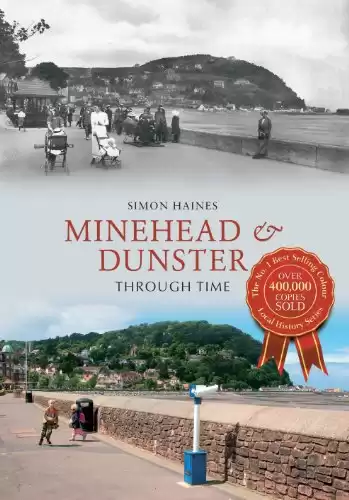
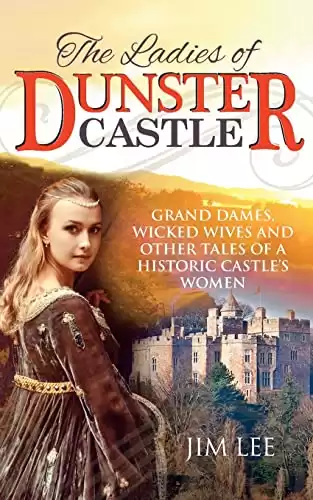
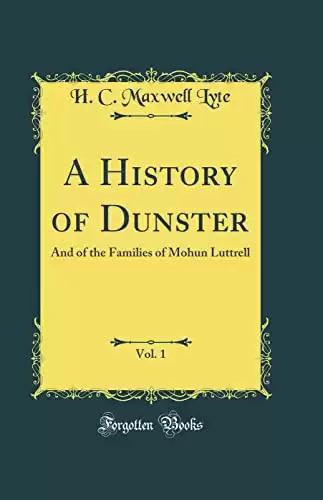
12 Comments
Comments are closed.